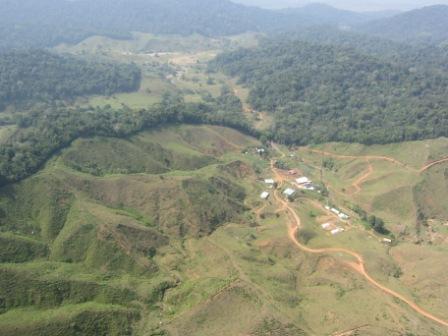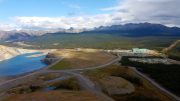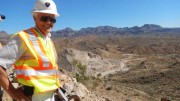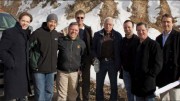MEDELLÍN, COLOMBIA — Junior explorer Touchstone Gold (TCH-T, TGL-L) believes its Segovia high-grade gold project in northwestern Colombia is one of the more exciting mining stories coming out of the country, which over the past few years has transformed its tarnished image into one gleaming with promise.
“Colombia has a great history in gold mining but had been closed to mining investment for decades due to civil unrest, leaving much of the country under-explored,” says company CEO David Wiley.
The resource-rich nation was once a driving force behind the Spanish Empire and the top gold producer in the Americas until 1937. After this it was paralyzed with drug violence and political corruption.
Colombia cleaned up its act and improved its security situation in the early 2000s, which piqued the interest of many mineral explorers and miners, exploding into a gold rush in 2009 and 2010, before cooling off.
“Nearly fifteen years ago some of the large companies, like AngloGold, came into Colombia and had large budgets to do explorations, and they were very successful,” Touchstone’s consulting geologist Alan Miller mentions over dinner during a humid April evening in Medellín.
“But there were parts of Colombia that were absolutely a no go. And the area that Touchstone has was a no-go area,” Miller says, sitting at a straw-roofed restaurant flanked by palm trees. The project area became safe to work in around 2007, leaving it relatively untouched until then, he adds.
The junior’s prized asset lies in the Segovia gold belt, some 150 km northeast of Medellín, Colombia’s second largest city and the capital of the Antioquia department.
“You’ve got an area that has been vastly underexplored, and given the grade and the new-found ability to go in and do active exploration, it is truly an exciting place to be,” Wiley says in a later interview in his Toronto boardroom. “High grade is the biggest differentiator for projects these days.”
Much of the renewed exploration in Colombia has centred on the Middle Cauca gold belt, one of the country’s three main gold belts, boasting large but low-grade deposits — such as AngloGold Ashanti’s (AU-N) La Colosa gold project, which averages around 1 gram gold per tonne.
Given the growing concerns around financing, which include capital-demanding projects, Touchstone suggests the market favours high-grade projects similar to those found in the Segovia-Remedios gold district. It points out that Gran Colombia Gold’s (GCM-T) Segovia operations in the area host an average grade of 9.3 grams gold.
Touchstone’s Segovia gold project — bordered to the south by Gran Colombia’s operations— consists of 11 mining concessions that include the advanced Rio Pescado deposit and the promising San Miguel, Frontino Norte and El Cinco properties.
The Rio Pescado property is located 15 km north of the Segovia-Remedios gold camp. Geologically it occurs along a structural trend that extends northward from the district, which is known for its history of gold production. Total gold content from that camp over the past 150 years has been estimated at 24 million oz., with 5.5 million oz. coming from the Frontino gold mines, including El Silencio and Providencia, which Gran Colombia acquired in 2010, and is running as part of its Segovia operations.
“Looking at this district and its certainly of scale — it has large deposits, and therefore the criteria from a historical point of view is that this is a gold district worth coming back to and looking at,” Miller notes.
Outlining the asset’s recent history, Miller says that around 2007 word got out that there were vein-quartz-bearing boulders in the area. This attracted the Colombian government, which carried out a reconnaissance geological survey. Shortly after, Cambridge Mineral Resources bought the land and explored the area for two years, before handing it off to Touchstone in 2009.
At the time Touchstone was a private firm founded by current director Ilyas Khan, a U.K.-based investment banker, who was looking for a partner to take the company public.
Khan met with Robert Buchan, the founder, chairman and CEO of Allied Nevada Gold (ANV-T, ANV-N) and the founder and former CEO of Kinross Gold (K-T, KGC-N), who saw potential in Touchstone’s original land package containing the Rio Pescado deposit. He contacted Wiley, co-founder and former CEO of Elgin Mining (ELG-T), to steer Touchstone under new management in 2011.
Touchstone listed on the London Stock Exchange’s AIM market that June and debuted on the Toronto Stock Exchange in December 2012. Its senior management consists of chairman Buchan, CEO Wiley, chief financial officer Brian Morales, chief geologist John Nicholson, consulting geologist Alan Miller, country manager Irene Meja and senior vice-president of corporate development Tom Elkins. Its management and directors control over 40% of the junior’s 201.3 million shares outstanding.
Getting to the Segovia project via helicopter from Medellín’s city airport takes 45 minutes. By car, the trek takes up to eight hours.
After a safety briefing, the small group visiting the project hopped onto a chopper that rose above the bustling city, flying over the surrounding mountains and villages, and passing along a stretch of rolling hills before landing near a forest reserve. More than half of Colombia is covered by forests.
After disembarking the helicopter, Nicholson gave a quick tour of Segovia’s camp facilities.
The site is 6 km from the electric grid and has a nearby water supply. Elevation in the area ranges from 210 to 270 metres above sea level.
Over the years the junior has modernized the camp, installing new generators and fuel storage to support year-round exploration. It has added a new kitchen and air conditioning. The seven-tent camp can service up to 60 employees, though the workforce on-site now stands at 30.
The junior has improved accessibility by carving out trails to the various zones and upgrading a private road to the village of Laureles, 11 km away.
Between here and Laureles, Nicholson says there are a half-dozen farms and no indigenous groups in the area. Cattle and horses graze the open land.
The zones on the rugged 247 sq. km property are accessible by mules or all-terrain vehicles (ATVs), with the company mostly relying on the latter.
While several armed guards are visible on camp, Nicholson says there are about 60 military personnel at any given time patrolling the perimeter. This safety measure costs US$100,000 to US$150,000 a year.
“There are FARC in the area,” Nicholson explains. “You just have to be aware of it. It’s no big secret. Colombia is Colombia. You’ve got FARC and ELN.” He adds that fortunately there have only been two minor scuffles between the military and rebel groups near the project area over the last three years, and Touchstone’s staff and facilities were not affected.
“We’re sleeping with both eyes shut rather than one open,” Touchstone’s chief geologist says, while guiding the group towards the exploration office.
“I think — not just because I’ve worked here for two and a half years — that the project does possess tremendous potential,” Miller says, who’s a consulting geologist from GeoMinEx, a firm that Touchstone contracted to explore the property.
He says that when Touchstone’s exploration team arrived in 2011, they visited as many mines as they
could in the Segovia-Remedios gold camp to better understand the regional geology.
Touchstone’s property is located on land that has similar characteristics to the Segovia-Remedios camp, Miller says, noting that it contains juxtaposed terrains, crustal-scale shear zones and major transposition along fault zones. “That means generally there is a lot of fluid flowing through these large crustal fault zones, which are the hydrothermal systems that could make ore,” he says.
Along with assessing the district, the geological team compiled previous exploration data from the Segovia project. This included re-logging the core, examining Cambridge’s geophysics and reinterpreting the data so that it could build a model to understand the property.
Segovia’s gold mineralization is hosted in large, mostly fractured lenticular zones of milky quartz, with gold-associated sulphide mineralization comprising mostly pyrite and some chalcopyrite, sphalerite and galena, and rare arsenopyrite, the junior explains.
It says a main north–south shear zone and a secondary northwest–southeast shear zone hosts gold-associated vein mineralization with nearly horizontal lenticular veins and nearly vertical veins on the property.
When Touchstone began exploring, it focused on the nearly flat veins that were being mined by artisanal miners at Segovia, but it has switched its efforts to the higher-grade vertical veins.
In 2011, Touchstone’s exploration team conducted several geophysical surveys cutting over 100 line km of grid. This helped them gather over 2,400 soil samples that outlined potential gold targets. Next the team initiated two stages of diamond drilling, focusing on Rio Pescado’s Pepas, Gap Area, Filo de Hambre and 1141 zones. It followed up on the results with a third drill program that concluded in early 2012.
Altogether it drilled over 15,000 metres in 193 holes on the Segovia property, of which 8,300 metres in 74 holes were drilled on Rio Pescado from June 2011 to March 2012.
Highlights from the wholly owned Rio Pescado deposit include: 28.3 metres grading 8.75 grams gold per tonne, 16.8 metres of 8.70 grams gold, 21.8 metres of 5.84 grams gold and 8.4 metres of 14.07 grams gold. All of these intercepts started near surface.
Rio Pescado has an 800-metre drill-tested strike length, while the larger Segovia project has a prospective strike length that exceeds 15 km.
Also in 2012, Touchstone substantially expanded its original 31 sq. km package through two acquisitions. That September, it acquired the private company, Atlantis Gold Mines, to add the San Miguel and Frontino Norte projects. A month later, the junior scooped up Yamana Gold’s (YRI-T, AUY-N) 60%-held El Cinco property, southwest of Rio Pescado. Touchstone holds 60–100% interests on the amalgamated gold property.
Following the presentation at the exploration office, the group took ATVs to tour the drill-permitted Rio Pescado property, stopping to observe drillers working on the third hole of the 2013 program.
The junior intends to drill 15,000 metres throughout the year in three phases while expanding areas of known gold mineralization and testing advanced targets.
The first phase of the program will consist of 5,000 metres of infill and stepout drilling, with a focus on Rio Pescado’s 1141, Tagual and Bern zones.
The 1141 zone is a mesothermal gold zone that has returned the best values to date, such as 28.3 metres of 8.75 grams. It sits 200 metres south of the Filo de Hambre zone. The Tagual zone contains a 400-by-1,000-metre gold geochemical signature that hosts gold-bearing quartz vein material. It sits east of the Pepas zone, named after the Pepas brothers, who are artisanal miners operating on two hectares of the property.
The Bern zone lies southeast of Filo de Hambre and contains a large gold-tellurium geochemical anomaly. It is believed to continue south onto the El Cinco property, something Touchstone plans to test this year. It also aims to drill the San Miguel property, once it receives a drill permit.
San Miguel boasts the promising Coturu trend that hosts gold mineralization similar to that seen at Gran Colombia’s El Silencio mine.
Gold mineralization at the San Miguel area is associated with minor amounts of base metal sulphides, whereas Rio Pescado is contained within a gold-telluride environment, resulting in cleaner ore.
Back in Toronto, CEO Wiley notes that once drilling wraps up Touchstone will calculate a resource estimate for Rio Pescado, expected by year-end.
“We’d like to move Rio Pescado closer to production and continue to permit and do some work over in the San Miguel area. Like the Rio Pescado area, it is also attractive,” he says.
While it’s still early days at the Rio Pescado project, Wiley believes it would be relatively straightforward to build and mine.
The costs should be considerably lower than most because the project is shallow and high grade, he asserts. “It’s almost like building a highway: It’s not a massive open pit as much as it is just a wide zone the width of a four-lane highway.”
Initial metallurgical tests on several samples from the Pepas zone returned recoveries of 88–95% gold in flotation concentrate, with cyanide-leaching producing recoveries in the range of 41–91%. A mine could potentially start production in 2016.
Touchstone ended the first quarter with US$2.4 million in cash and equivalents. Shares closed June 11 at 3.5¢, their 52-week low, after reaching a yearly high of 16¢ last December. At last count, there were 201 million shares outstanding, for a $7-million market capitalization.






Be the first to comment on "Touchstone looks to score in Colombia"